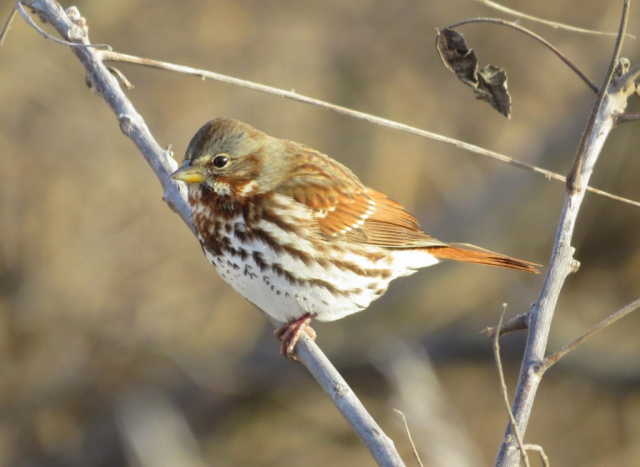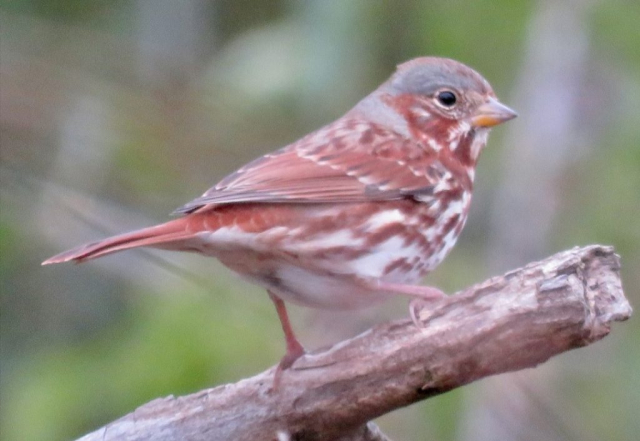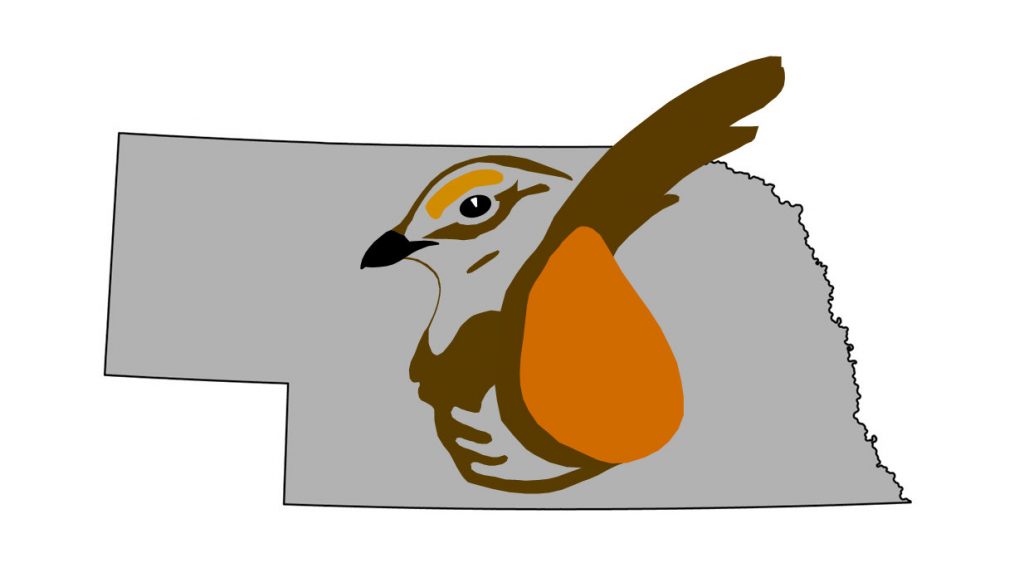Passerella iliaca zaboria, P. i. iliaca
Status: Fairly common regular spring and fall migrant east, uncommon east-central, rare casual west-central and west. Uncommon regular winter visitor southeast, rare casual elsewhere.
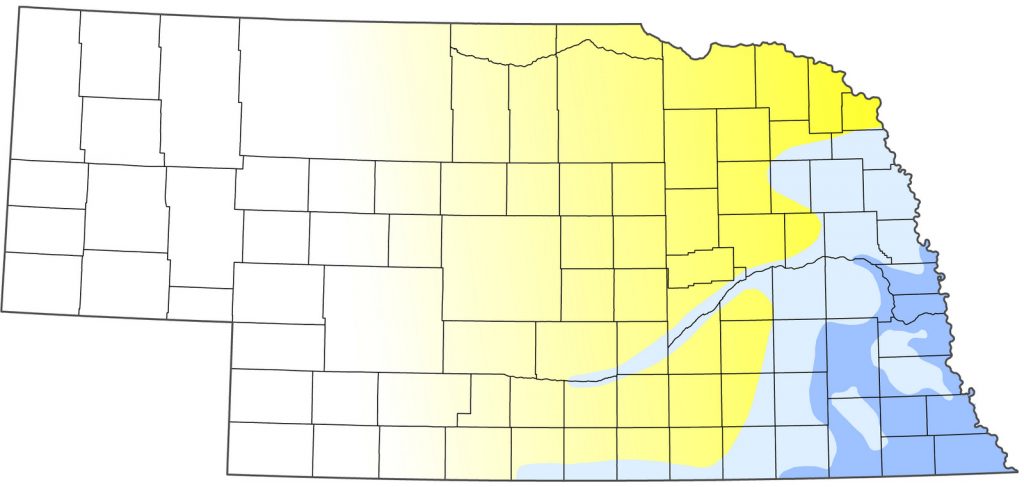
Documentation: Specimens: iliaca?, UNSM ZM17887, 21 Oct 2000 Lincoln, Lancaster Co; zaboria? UNSM ZM18334, 7 Nov 2005 Dodge Co (see Taxonomy).
Taxonomy: Fifteen subspecies are recognized (AviList 2025).
The subspecies have been divided into four putative species groups (Pyle 1997): Sooty Fox Sparrow (P. unalaschcensis), Thick-billed Fox Sparrow (P. megarhyncha), Slate-colored Fox Sparrow (P. schistacea), and Red Fox Sparrow (P. iliaca). Recent mitochondrial studies (Zink 1994, Zink and Weckstein 2003) and opinion (Wright 2019) indicate species status. Nevertheless, AOS has not accepted this position, expressing (AOU 1998) reservations regarding the hybrid zone between megarhyncha and schistacea, a concern noted also by Gill et al (2024). AviList (2025) retained the four groups within Fox Sparrow P. iliaca pending publication of current genomic studies and data on hybrid zone characteristics.
Red Fox Sparrow is the only one of the four proposed species that occurs in Nebraska, although there are numerous records of Slate-colored Fox Sparrow close to Nebraska in neighboring Colorado and Wyoming (eBird.org, accessed Jul 2025). See Comments (below) regarding Slate-colored Fox Sparrow.
According to Weckstein et al (2020), Red Fox Sparrow subspecies are P. i. zaboria, breeding from interior Alaska to central Alberta south to Northwest Territories and Manitoba, wintering from southern California to south Texas, north and east to Iowa and Georgia, and P. i. iliaca, breeding from northeast Manitoba and Ontario to Newfoundland, wintering from Michigan to Mississippi east to New Hampshire and Florida.
Pyle’s proposed placement of altivagans of interior British Columbia and southwestern Alberta, wintering California to Arizona, was either with the Red group or the Slate-colored group; genetic studies (Zink 1994, Zink and Weckstein 2003) confirm its inclusion in Slate-colored Fox Sparrow as P. schistacea altivagans. There are no confirmed Nebraska records of altivagans and it is unlikely to occur in Nebraska based on its currently accepted range.
All Nebraska observations are of Red Fox Sparrow; it has been assumed that subspecies P. p. iliaca and P. p. zaboria migrate through Nebraska (Bent 1968; Pyle 1997). Both iliaca and zaboria Red Fox Sparrows winter in the southeastern US. Since zaboria breeds westward into Alaska, its fall migration route is on the northern Great Plains including Nebraska. All Oklahoma specimens (>35) are zaboria (Joe Grzybowski, personal communication). Subspecies iliaca breeds west in Canada to the longitude of Minnesota, and winters with zaboria in the southeastern US. Thus, iliaca migrates southward and southeastward and could be expected to be less numerous in Nebraska than zaboria. In addition, intergrades might be expected to occur in at least eastern Nebraska. Field identification of these two subspecies in Nebraska is difficult, with only extremes of rosy red (iliaca) and brownish rufous (zaboria) plumages possibly identifiable, as suggested by Beadle and Rising (2003). Probable examples from Nebraska of such extremes are a brownish rufous bird photographed in Dawes Co 13 Oct 2018 (Jorgensen 2018), a bird suggestive of zaboria picked up in Dodge Co 7 Nov 2005 and sent to UNSM, now ZM18334 (cited above), and reddish birds that are good candidates for iliaca: the specimen cited above, which is a fresh, very rosy reddish bird from Fontenelle Forest, Sarpy Co 5 Mar 2017 (Peterson 2017); 25 Mar 2017 Dodge Co (Croshaw 2017); and 23 Oct 2021 Knox Co (photograph in this account).
Pyle (2025) synonymized zaboria and iliaca based on their not meeting the generally accepted 75% rule for subspecies diagnosability.
Spring: winter <<<>>> Apr 26, 27, 28 (south and east); Mar 20, 20, 21 <<<>>> Apr 9, 9, 10 (north and west)
Later dates south and east are 2 May 2024 Lancaster Co, and 5 May 2018 Saunders Co.
Earlier dates north and west are 15 Mar 2016 Garfield Co, and 16 Mar 2015 Brown Co.
Later dates north and west are 16 Apr 2018 Knox Co, and 19 Apr 2018 Antelope Co.
Migration is from late Mar through Apr; peak movement is in early Apr in the southeast, mid-Apr elsewhere.
There is one documented Panhandle report, a single brownish rufous Red Fox Sparrow photographed in Morrill Co 18 Apr 2014. On the eastern Colorado plains, Fox Sparrow was listed as a rare migrant by Andrews and Righter (1992) and in eastern Wyoming it is a rare migrant, “presumably iliaca/zaboria” (Faulkner 2010).
- High counts: 62 at Fontenelle Forest 1 Apr 2017, 25 there 5 Apr 2009, 23 there 29 Mar 2005, and 22 at Wood Duck WMA, Stanton Co 1 Apr 1998.
Fall: Sep 29, 30, Oct 1 <<<>>> winter
Earlier dates are 11 Sep 2010 Wind Springs Ranch, Sioux Co, 26 Sep 2012 Douglas Co, and 27 Sep 2016 Dawes Co.
Later dates include a number of CBC reports, with high counts of 19 on the DeSoto NWR CBC 29 Dec 2012, 17 on the Branched Oak Lake-Seward CBC 17 Dec 2009, and 13 there 15 Dec 2007. In 2015, a total of 21 were reported on CBCs, all in the southeast, including nine on the Branched Oak Lake-Seward CBC 20 Dec 2015. There are several Jan reports.
Migration is from Oct through late Nov, with peak numbers in late Oct-early Nov, although fall departure is protracted, especially in the southeast, where a few overwinter.
Fox Sparrow occurs farther west in fall, though still rare in the Panhandle, with reports 11 Sep 2010 Wind Springs Ranch, 27 Sep 2016 Dawes Co, 29 Sep 2012 Scotts Bluff Co, 4 Oct 2020 Scotts Bluff Co, 8 Oct 2015 Kimball Co, 10 Oct 2020, Scotts Bluff Co, 13 Oct 2018 Dawes Co, 8 Nov 2015 Kimball Co, and 8 Nov 2022 Scotts Bluff Co.
Reports from the west-central, where the species is less than annual, are 9 Oct 2019 Red Willow Co, 9 Oct 2020 Dundy Co, 11 Oct 2024 Lake McConaughy, Keith Co, 16 Oct 2012 Lincoln Co (reported as “Red”), 20 Oct 2023 Anderson Bridge WMA, Cherry Co, and 29 Oct 2015 two at Wood Lake, Cherry Co.
- High counts: 32 at Boyer Chute NWR, Washington Co 18 Oct 1998, 18 at Wood Duck WMA 28 Oct 1997, and 15 at Fontenelle Forest 2 Nov 2016.
Winter: Prior to the winter of 2009-2010, there had been only about 25 reports in Feb, indicating that overwintering was less than annual. Since then, however, this species has wintered increasingly in the southeast in good numbers. In 2013-2014 there were 12-13 birds reported at five locations through 22 Feb, and in 2014-2015 at least 16 individuals were at 11 locations in the southeast. Continuing the trend, in winter 2017-2018 there were an amazing 34 individuals reported Jan-Feb. Even though numbers observed in winter are variable, reports have increased in recent years including numbers recorded on CBCs (Figure 1).
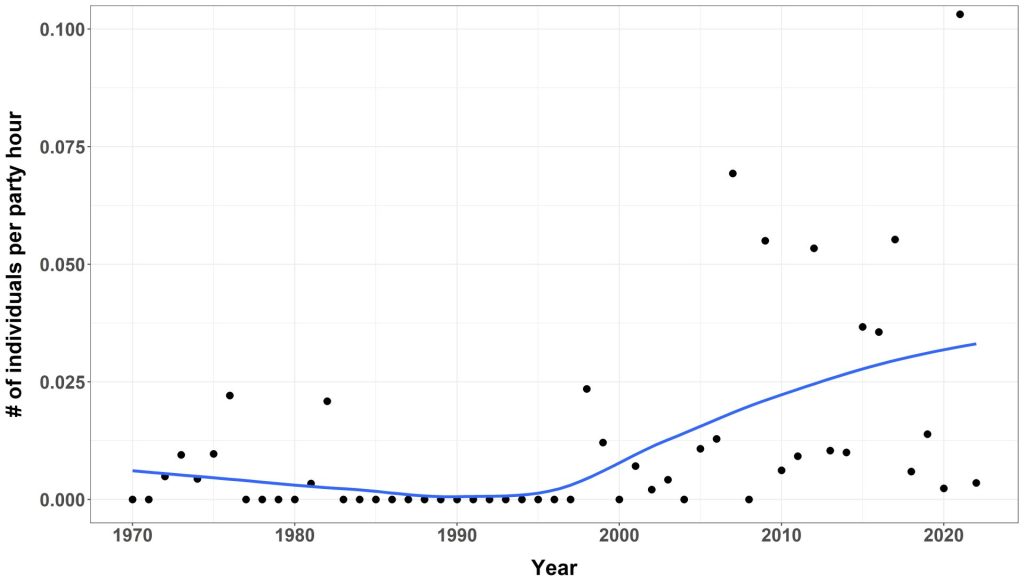
Figure 1: Number of Fox Sparrows detected per party hour on Nebraska Christmas Bird Counts during the period 1970-2022. Points represent reported values and trend line created using locally weighted scatterplot (LOESS) smoothing. Data collected by volunteers and provided by National Audubon Society and the Nebraska Ornithologists’ Union.
In winter 2021-2022, by far record numbers wintered in the east, the reports extending farther north and west than usual. A rather incredible 151 birds were reported Jan-Feb, compared to the previous high total for Jan-Feb of 34. Single observer-single location counts were topped by the 25 at Timber Point RA, Butler Co 27 Feb. The extent of wintering was defined by reports from Boyd Co 4 Jan, Wayne Co 5 Jan- 19 Feb (up to four), Stanton Co 10 Jan and 30 Jan, Merrick Co 11 Jan and 15 Feb, Kearney, Buffalo Co 9 Jan, and Harlan Co 21 Feb. In winter 2023-2024, 99 were estimated. High recent winter counts may be a consequence of increasing spread of eastern red cedar whose berries are a food source for this species (Shari Schwartz, John Carlini, personal communication).
Away from the southeast, there are few reports of overwintering or of birds seen in Feb. Westerly was one 29 Dec 1964-1 Feb 1965 in Scotts Bluff Co, one was at a feeder in southeast Lincoln Co 9-14 Feb 2014, one was at Pressey WMA, Custer Co 14 Feb 2015, and one was in Custer Co 27 Feb 2013, while northerly were one wintering 2010-2011 in Winside, Wayne Co and still present 7 Mar 2011, and a series of sightings at Ike’s Lake, Wayne Co of up to four birds 5 Jan-19 Feb 2022. Perhaps defining the expected limits for most winters were one that wintered at feeders in Hooper, Dodge Co 2009-2010, three that wintered at a Platte Co feeder 2012-2013, one in Kearney, Buffalo Co 20 Jan 2019, apparently the same bird in the same place 23 Dec and 11 Jan 2020, and three in Franklin Co 15 Feb 2015.
Comments: The occurrence of schistacea in Nebraska is based on the purported collection of a specimen (USNM A 5718) in southwest Nebraska 19 July 1856 (Deignan 1961), the location described as “Head of the Platte = south fork of the Platte River, about 25 miles east of the northeastern corner of Colorado, in Nebraska” (AOU 1957, Deignan 1961). The accuracy of this location is questionable for several reasons, as outlined in Silcock (2021). As suggested by Wright (2019), “it seems most plausible that the bird was mis-labeled, or the date was misread”. Silcock (2021) presented a case that indeed the collecting locality of the specimen was almost certainly within its breeding range in the northern Medicine Bow Mountains in Wyoming between 7 and 25 August 1856 rather than in Nebraska on 19 July 1856.
No details were provided by Swenk (1919) to support his statement that schistacea was an “uncommon migrant westwardly.”
Images
Abbreviations
AOS: American Ornithological Society (formerly American Ornithologists’ Union)
CBC: Christmas Bird Count
UNSM: University of Nebraska State Museum
WMA: Wildlife Management Area (State)
Literature Cited
Andrews, R., and R. Righter. 1992. Colorado birds. Denver Museum of Natural History, Denver, Colorado, USA.
American Ornithologists’ Union [AOU]. 1957. The AOU Check-list of North American birds, 5th ed. Port City Press, Baltimore, Maryland, USA.
Baird, S.F., J. Cassin, and G.N. Lawrence. 1858. Reports of Explorations and Surveys to ascertain the most practible [sic] and economic route for a railroad from the Mississippi River to the Pacific Ocean [etc]. Vol. 9. Washington DC: A. O. P. Nicholson.
Beadle D., and J. Rising. 2003. Sparrows of the United States and Canada. The Photographic Guide. Princeton University Press, Princeton, New Jersey, USA.
Bent, A.C. 1968. Life histories of North American Cardinals, Grosbeaks, Buntings, Towhees, Finches, Sparrows, and allies. Bulletin of the United States National Museum 237. Three Parts. Dover Publications Reprint 1968, New York, New York, USA.
Bryan, F. 1945. Report of Lieut. F.T. Bryan concerning his operations in locating a practicable road between Fort Riley to Bridger’s Pass 1856. Annals of Wyoming 17: 24-55. https://ia800702.us.archive.org/0/items/annalsofwyom17121945wyom/annalsofwyom17121945wyom.pdf.
Clements, J.F., T. S. Schulenberg, M.J. Iliff, D. Roberson, T.A. Fredericks, B.L. Sullivan, and C.L. Wood. 2016. The eBird/Clements checklist of birds of the world: v2016, accessed 30 January 2018.
Cooke, W.W. 1897. The Birds of Colorado. Colorado State Agricultural College, Fort Collins.
Croshaw, C. 2017. eBird checklist S35425193: Dodge Co, Nebraska.
Deignan, H. G. 1961. Type Specimens of Birds in the United States National Museum. U.S. Natl. Mus. Bull. 221.
Faulkner, D.W. 2010. Birds of Wyoming. Roberts and Company, Greenwood Village, Colorado, USA.
Gill, F., D. Donsker, and P. Rasmussen (Eds). 2024. IOC World Bird List (v 14.2). Doi 10.14344/IOC.ML.14.2. http://www.worldbirdnames.org/.
Goetzmann, W.H. 1959. Army exploration in the American West 1803- 1863. Lincoln, Nebraska: University of Nebraska Press.
Jackson, W.T. 1949. The Army Engineers as Road Surveyors and Builders in Kansas and Nebraska, 1854-1858. Kansas Historical Quarterly 17: 37-59.
Jorgensen, J.G. 2018. eBird checklist S49157281: Dawes Co, Nebraska.
Moore, J.A. 1986. Zoology of the Pacific Railroad Surveys. American Zoology 26: 331-341.
Peterson, B. 2017. eBird checklist S34987164: Sarpy Co, Nebraska.
Pyle, P. 1997. Identification Guide to North American Birds. Part I, Columbidae to Ploceidae. Slate Creek Press, Bolinas, California, USA.
Pyle, P. 2025. A Practical Subspecies Taxonomy for North American Birds. North American Birds 76(1).
Silcock, W.R. 2021. Locality and date of collection of the type specimen of the Slate-colored Fox Sparrow. Western Birds 52: 165–167. doi 10.21199/WB52.2.6.
Swenk, M.H. 1919. The Birds and Mammals of Nebraska. Contributions of the Department of Entomology No. 23. Lincoln, Nebraska.
Weckstein, J.D., D.E. Kroodsma, and R.C. Faucett. 2020. Fox Sparrow (Passerella iliaca), version 1.0. In Birds of the World (A. F. Poole and F. B. Gill, Editors). Cornell Lab of Ornithology, Ithaca, NY, USA. https://doi.org/10.2173/bow.foxspa.01.
Williams, F. 1980. Southern Great Plains Region. American Birds 34: 176-179.
Wright, R. 2019. Sparrows of North America. Peterson Reference Guide, Houghton Mifflin Harcourt, Boston and New York, USA.
Zink, R.M. 1994. The geography of mitochondrial DNA variation, population structure, hybridization, and species limits in the Fox Sparrow (Passerella iliaca). Evolution 48: 96-111.
Zink, R.M., and J.D. Weckstein. 2003. Recent Evolutionary History of the Fox Sparrows (Genus: Passerella). Auk 120: 522-527.
Recommended Citation
Silcock, W.R., and J.G. Jorgensen. 2025. Fox Sparrow (Passerella iliaca). In Birds of Nebraska — Online. www.BirdsofNebraska.org
Birds of Nebraska – Online
Updated 9 Sep 2025
